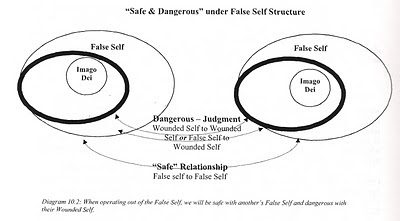You know how you can never eat just one peanut m&m? And do you also know how most peanut shells have two peanuts in them? We, as peanut m&ms, were created to be in relationship with one another. Katie Skurja writes about the Imago Dei peanut, “In this model, I am suggesting that the Imago Dei is the way we were designed to live in a triune relationship, just as the Father, Son, and Holy Spirit live in relationship to one another. The image of God, or Imago Dei, within us is how we were created for relationship with God, others, and self….There is an inter-connectedness and mutuality among the three and a two-way flow between any two persons of the relationship.”
Just as there is a mutuality and sharing among the trinity, so is there to be a mutuality and sharing between us, respect and love. We are to treat each other as we would Christ as Christ is in every person for indeed, he is! And this Imago Dei is in every person no matter who they are or where they have come from. Katie explains, “The Imago Dei is at the core of all people, regardless of how much they seem to be in the light or not, though not all live out of their Imago Dei. All people can be used to reveal aspects of who God is, both believers and non-believers alike. The very people we consider to be our enemies can reflect aspects of God that we do not see with our natural eyes…. Some believe that the Imago Dei was destroyed by the Fall and that it is only in being ‘born again’ that it is restored. This viewpoint sets one up for judgement of others and promotes the ‘I/it’ or ‘us/them’ attitude. Jesus himself told us that what we do unto others we do unto him (Matthew 25:40). If we adhere to the idea that only Christians have an Imago Dei, then we will have a tendency to look at others for what they are not rather than who they are. We will not see how they might have something to offer us. This judgement is often not only toward those outside the Church, but also within.”
If we truly do believe scripture when it says all people were created in the image of God, then we need to love every person on this earth, past, present, and future, no matter how much chocolate their peanut is covered up with, including ourselves. Each person is a unique expression of God and we need to look for the good and the light inside them. Even if they have a hard time seeing past their own chocolate and their shame, as we live out of our own Imago Deis, we can help them see theirs. We can hold up a divine mirror and help others see the treasured gem of God they are. I will be the first to admit this can be easier at times more than others but I also know it is always rewarding, even if not easy. But we are called to share God’s love and how can we do that if we do not try to see through his eyes?
Between the candy coated shell, our chocolate, and our peanuts, there are many ways to relate to each other. The “safe relationship” is when we interact with our candy coated shells firmly in place, our “false selves” wearing the masks of who we want to present to the world. The false self wants to maintain the status quo, protect itself, and not have anyone ever see their chocolate. However, by living out of the false self, God’s image is rarely ever seen. We all have such relationships in our lives, some churches are full of them. We aren’t real with each other, either with our shame or who God created us to be. Of the false self, Katie says, “The mantra of shallow False-Self relationships is “don’t rock the boat.” We may even pride ourselves on how tolerant we can be in accepting other people’s differences, yet we are blind to who the person really is at the core. Looking we do not see, listening we do not hear.” She goes on to tell us, “Our False-Self is not capable of Agape love, or Christ-like love. It can do loving things, but not love in the way that God loves. The harsh truth is that whenever we look at someone with contempt or hatred, we are not operating out of the Imago Dei…. We can only know ourselves or others to the degree that we function out of the Imago Dei within us.”
When explaining how the false self operates in closer relationships, Katie tells us, “The more intimate our relationships, the more our False Self begins to break down in that relationship. Unfortunately, that does not necessarily mean that we operate our of the Imago Dei. On the contrary, it is where we can often be the most dangerous because we no longer show the pretenses of the False Self. This “honor” we usually reserve for those we presume to love the most. Those closest to us will have opportunity to see the places where the chocolate is leaking out from underneath our False Self.”
When two people operate out of their chocolate, our “wounded selves”, it’s like two people with sunburns bumping up against each other. No matter where they touch, it’s going to hurt. This can be a very dangerous and explosive type of relationship. Their issues are at the forefront, everything said touches on a much deeper issue. For example one spouse might say to another over some dishes left in the sink, “You never help clean up around here!” That is the wounded self. Another example is when a child spills a glass of milk at dinner and the parent beats them in a back room as punishment. That is the wounded self too. This is not the true self God created us to be but it is the self many of us operate out of.
Another dangerous relationship is when one person is living out of their false self and the other out of the wounded self. This often happens when there is a power differential in a relationship, when it is a one-up and one-down way of relating. Katie explains, “The greater the power differential, the greater the likelihood that the relationship will be dangerous. Power itself is not good or bad. It is neutral, but can be used for good or evil. In linear relationships, power will invariably be used for self-serving purposes. In this type of False-Self-to-Wounded-Self relationship one may be a burn victim, but the other is a porcupine, forever shooting it’s dangerous quills. Abusive relationships operate in this manner, whether the quills come from the tongue, the fist, attitudes, or behaviours. The person in the one-up position projects his/her shame onto the person in the one-down position as a means of self-preservation.”
Here is a diagram illustrating the different types of relationships we’ve just discussed. (Click on picture for larger image.)

Tomorrow I will talk about living out of our Imago Deis in relationship with one another. For now, think about movies you’ve seen or people you know and come up with examples of people living out of their false-self, wounded-self, and their Imago Dei. What does it look like when these people interact? When have you seen yourself living out of each of these areas? What were those experiences like? Share your answers with God or write a comment below. (God reads this blog too.)
*Quotes and diagram taken from Living in the Intersection by Catherine Skurja. Used with permission.


So, um, you know, I really really like the general direction of this post and some parts of your metaphor really work for me, but WHAT IS YOUR PROBLEM WITH CHOCOLATE??? I am not sure I want to hear, "read the whole book…"
I mean it's not really like you're talking about ecology or fair trade production or the power and wonder of chocolate in small and measured doses. It's just that no chocolate at all is not at all a leap I think a lot of relationships can sustain. Here I am not seeing the path away from chocolate mess and into the GOOD parts of chocolate.
So, to treat one as they truly are means you always treat them like a peanut, even though they are hiding behind a candy coated shell, or deep in a chocolate mess?